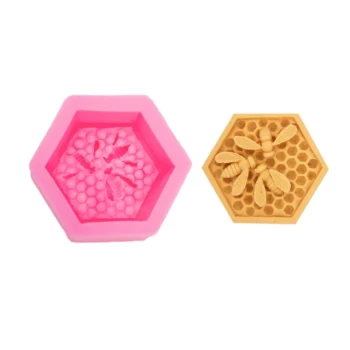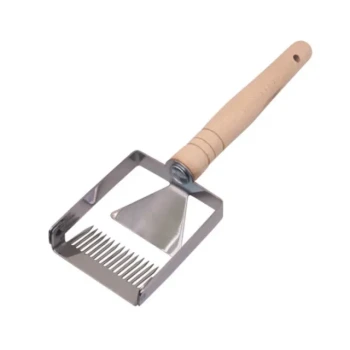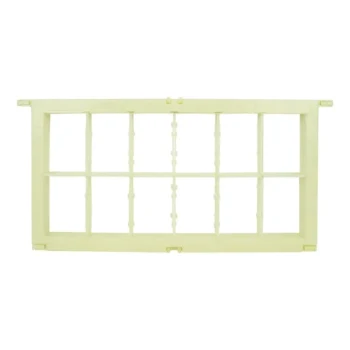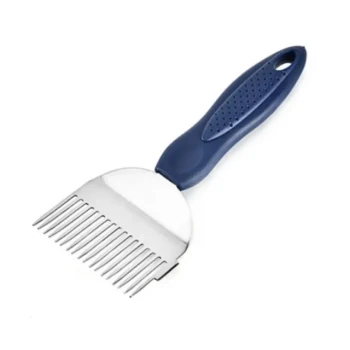Proper ventilation is critical for beehives in hot weather because it provides the airflow necessary for the colony to regulate its internal temperature. Without adequate ventilation, a hive can quickly overheat, stressing the bees, halting honey production, and potentially leading to the death of the brood or even the entire colony.
The core challenge is that a beehive is a living superorganism constantly managing its internal climate. Proper ventilation is not merely about letting in a breeze; it's about empowering the bees to efficiently control temperature, moisture, and air quality, which are the three pillars of a healthy and productive colony.
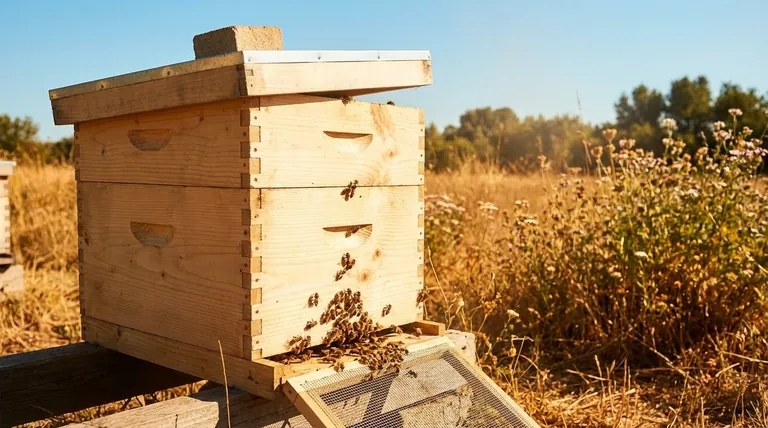
The Hive's Climate Control System
A beehive is a finely tuned environment. Bees work tirelessly to maintain the brood nest at a stable temperature, typically around 95°F (35°C), regardless of the weather outside. Ventilation is the key external factor that makes this internal control possible.
Pillar 1: Temperature Regulation
Bees cool their hive through evaporative cooling. They collect water, spread it on the comb, and then fan their wings to create airflow, much like a swamp cooler.
Effective ventilation creates a "chimney effect." Cool, fresh air is drawn in through lower entrances while hot, stale air is pushed out through upper vents, making the bees' fanning efforts significantly more efficient.
Without this assistance, bees expend enormous energy just trying to stay cool, a behavior known as bearding, where thousands of bees cluster on the outside of the hive.
Pillar 2: Moisture Control
A single colony generates a significant amount of moisture through two primary activities: respiration and curing nectar into honey.
Curing honey involves evaporating the high water content from fresh nectar. This water vapor must be removed from the hive.
In hot, humid weather, poor ventilation traps this moisture, creating damp conditions that are an ideal breeding ground for mold, mildew, and fungal diseases like chalkbrood.
Pillar 3: Air Quality Management
Like any living organism, a hive full of tens of thousands of bees consumes oxygen and produces carbon dioxide (CO2).
Stagnant, unventilated air leads to high concentrations of CO2 and other waste gases. This poor air quality stresses the bees and can weaken their immune systems.
Furthermore, pests like the Varroa mite are known to thrive in hives with high humidity and poor air circulation, making ventilation a key component of integrated pest management.
The Consequences of Poor Ventilation
Failing to provide adequate ventilation, especially during hot weather, can have cascading negative effects on the colony's health and productivity.
Overheating and Colony Collapse
In extreme heat, poor ventilation can be catastrophic. If the bees cannot cool the hive effectively, the internal temperature can rise to a point where the beeswax combs soften and collapse.
This results in the loss of honey, pollen, and, most critically, the brood (eggs, larvae, and pupae), which can lead to the rapid decline of the entire colony.
Reduced Productivity
A colony that is constantly fighting to cool itself is not a productive one. The energy bees spend fanning and collecting water is energy they are not spending on foraging for nectar and pollen.
This stress can also cause the queen to reduce or even stop laying eggs, which slows the colony's growth and reduces its workforce for honey production.
Making the Right Choice for Your Goal
Ventilation is not a one-size-fits-all solution; it should be adjusted based on your climate and specific goals.
- If your primary focus is surviving an intense heatwave: Provide maximum airflow by using a screened bottom board, propping the outer cover slightly open, and ensuring an upper entrance is available.
- If your primary focus is year-round hive health: Use a combination of a screened bottom board and a vented inner cover or upper entrance to ensure consistent moisture removal without creating excessive drafts in cooler seasons.
- If your primary focus is moving bees in warm weather: Prioritize secure, maximum ventilation with a screened moving cover to prevent the rapid and catastrophic overheating that can occur during transport.
Ultimately, viewing ventilation as a fundamental support for the bees' natural behavior is the cornerstone of proactive and successful beekeeping.
Summary Table:
| Ventilation Function | Benefit for the Hive | Risk of Poor Ventilation |
|---|---|---|
| Temperature Regulation | Enables efficient evaporative cooling | Overheating, wax comb collapse, bearding |
| Moisture Control | Removes excess humidity from curing honey | Mold, mildew, and fungal diseases (e.g., chalkbrood) |
| Air Quality Management | Expels CO2 and waste gases | Stressed bees, weakened immune systems, pest proliferation |
Protect your investment and ensure your colonies thrive. Proper ventilation is a cornerstone of successful apiary management. At HONESTBEE, we supply commercial apiaries and beekeeping equipment distributors with the durable, high-quality supplies needed to build and maintain well-ventilated, productive hives. From screened bottom boards to vented inner covers, our wholesale-focused operations provide the reliable equipment your business depends on.
Let's discuss your hive ventilation needs. Contact our team today to learn how our products can support your colony's health and honey production goals.
Visual Guide
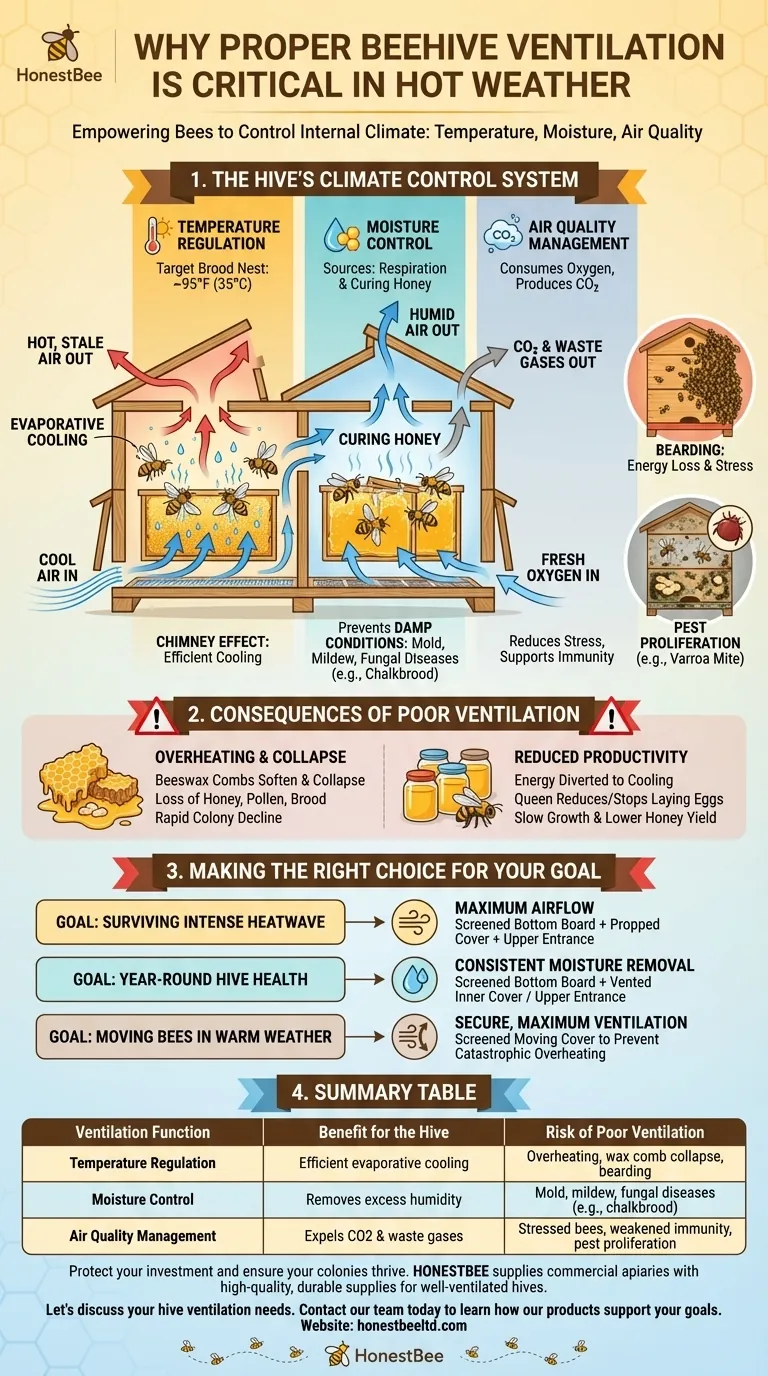
Related Products
- Wholesales Dadant Size Wooden Bee Hives for Beekeeping
- Long Langstroth Style Horizontal Top Bar Hive for Wholesale
- Professional Grade Foldable Beehive Handles
- Black Plastic Beetle Barn Hive Beetle Trap for Beehives
- 4 Frame Plastic Nuc Boxes for Beekeeping Bee Nuc Box
People Also Ask
- What types of products are available for beekeeping needs? Essential Equipment for Apiaries & Distributors
- Why were wooden hives traditionally preferred? For Natural Beekeeping Aligned with Bee Biology
- What is beekeeping equipment? Essential Tools for Commercial Apiaries & Distributors
- How often should the area under beehives be inspected and cleaned during the warm season? A Proactive Maintenance Guide
- What are the advantages of wooden bee hives? Superior Bee Health & Beekeeper Flexibility















